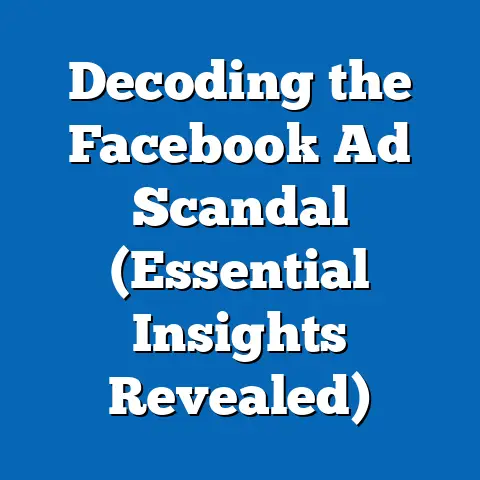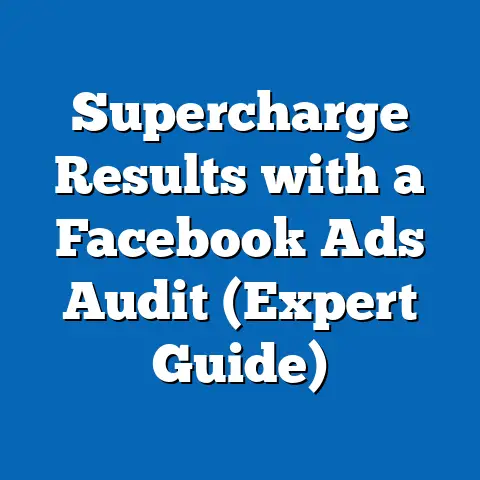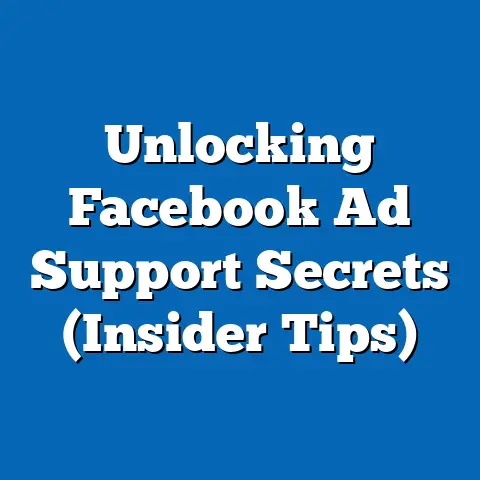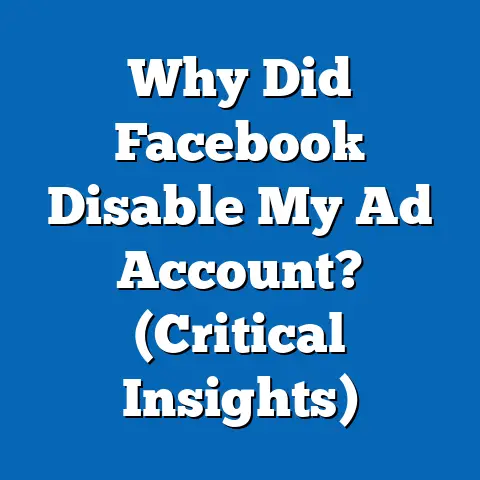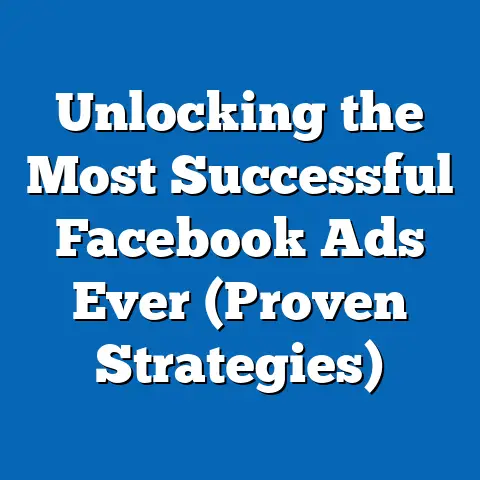Boost Blue Watch Sales with Effective fb ad Strategies (Pro Tips)
In an age where everyone is a self-proclaimed expert on social media marketing, it’s ironic that many brands still struggle to sell a simple blue watch online. After all, how hard can it be to promote a product that literally ticks all the boxes? We live in a digital world flooded with data, sophisticated algorithms, and a plethora of advertising tools. Yet, the gap between potential and performance remains a chasm for many businesses. It’s like having a state-of-the-art kitchen but still burning toast.
The truth is, having access to advanced tools and analytics doesn’t guarantee success. It’s about understanding how to use them effectively. It’s about knowing your audience, crafting compelling messages, and optimizing your campaigns based on real-time data. It’s about more than just posting pretty pictures and hoping for the best. It’s about strategy.
This article isn’t just another generic guide to Facebook advertising. I’m diving deep into the specific strategies that can boost your blue watch sales. I’ll share pro tips, real-world examples, and actionable insights that will help you transform your Facebook ad campaigns from a cost center into a profit driver. So, let’s roll up our sleeves and get to work.
Understanding the Target Audience
Before you even think about crafting an ad or setting a budget, you need to understand who you’re trying to reach. This isn’t just about demographics; it’s about psychographics, motivations, and pain points. Who are the people who are most likely to buy a blue watch? What are their interests? What are their values? What problem does a blue watch solve for them?
Demographics and Psychographics
Let’s start with demographics. Are you targeting men or women? What age range? What income level? Are they students, young professionals, established executives, or retirees? This information will help you narrow down your audience and target your ads more effectively.
But demographics are just the tip of the iceberg. Psychographics delve deeper into the psychological aspects of your target audience. What are their interests, hobbies, and lifestyles? Are they fashion-conscious, practical, adventurous, or conservative? What brands do they admire? What social media platforms do they use?
For example, you might find that your ideal blue watch buyer is a young professional, aged 25-35, with a mid-range income. They are interested in fashion, technology, and sustainability. They follow brands like Patagonia, Apple, and TOMS. They are active on Instagram, LinkedIn, and Pinterest.
Creating Customer Personas
Once you have a good understanding of your target audience, you can create customer personas. A customer persona is a fictional representation of your ideal customer, based on research and data about your existing customers and target market.
Creating a customer persona involves giving your ideal customer a name, a background, and a personality. What does their typical day look like? What are their goals and challenges? What are their fears and frustrations?
For example, you might create a persona named “Alex,” a 28-year-old marketing manager who lives in a city. Alex is stylish and tech-savvy. They are looking for a watch that is both fashionable and functional. They want a watch that they can wear to work, to social events, and on weekend adventures. They are also concerned about sustainability and want to support brands that are environmentally responsible.
By creating detailed customer personas, you can better understand your target audience and tailor your ads to their specific needs and interests.
Real-Life Examples
There are numerous brands that have successfully identified and targeted their audience. One example is MVMT Watches. MVMT started as a crowdfunding campaign and quickly grew into a multi-million dollar brand by targeting millennials and Gen Z with stylish, affordable watches. They used Instagram and Facebook to showcase their products and build a community around their brand.
Another example is Daniel Wellington. Daniel Wellington also targeted millennials with minimalist, elegant watches. They used influencer marketing and social media to create a sense of exclusivity and aspirational lifestyle.
Key Takeaway: Understanding your target audience is crucial for creating effective Facebook ad campaigns. By focusing on demographics, psychographics, and customer personas, you can tailor your ads to resonate with your ideal customer and drive sales.
Crafting Compelling Ad Copy
Once you understand your target audience, you need to craft compelling ad copy that grabs their attention and persuades them to buy your blue watch. This isn’t just about listing the features of your watch; it’s about telling a story and creating an emotional connection with your potential buyers.
Pro Tips for Persuasive Ad Copy
Here are some pro tips for writing persuasive ad copy that highlights the unique features of your blue watch:
- Focus on benefits, not just features: Instead of just saying “This watch is waterproof,” say “Enjoy worry-free adventures with our waterproof blue watch.”
- Use strong verbs and adjectives: Instead of saying “This watch is nice,” say “This watch is stunning, sophisticated, and durable.”
- Create a sense of urgency: Use phrases like “Limited time offer,” “While supplies last,” or “Get yours today.”
- Use social proof: Include testimonials, reviews, or user-generated content to build trust and credibility.
- Ask a question: Engage your audience by asking a question that relates to their needs or interests. For example, “Looking for the perfect accessory to elevate your style?”
- Use emojis: Emojis can add personality and visual appeal to your ad copy.
- Keep it concise: People are busy, so get to the point quickly and clearly.
The Importance of Storytelling
Storytelling is a powerful tool for creating an emotional connection with your potential buyers. Instead of just listing the features of your watch, tell a story about how it can enhance their lives.
For example, you might tell a story about a young professional who wears your blue watch to a job interview and lands their dream job. Or you might tell a story about an adventurous traveler who wears your blue watch on a backpacking trip and creates unforgettable memories.
By telling a story, you can make your ad more engaging and memorable. You can also help your potential buyers imagine themselves wearing your watch and experiencing the benefits it offers.
Examples of High-Performing Ad Copies
Here are some examples of high-performing ad copies in the watch niche:
- “The perfect blend of style and functionality. Our blue watch is designed for the modern adventurer. Waterproof, durable, and undeniably stylish. Get yours today and make every moment count.”
- “Looking for a watch that can keep up with your busy lifestyle? Our blue watch is built to last. With its scratch-resistant crystal and comfortable strap, you’ll never want to take it off. Shop now and experience the difference.”
- “Elevate your style with our stunning blue watch. Handcrafted with premium materials and attention to detail, this watch is a true masterpiece. Limited time offer: Get 20% off your first order.”
Key Takeaway: Crafting compelling ad copy is essential for grabbing attention and persuading potential buyers to purchase your blue watch. Focus on benefits, storytelling, and creating an emotional connection with your audience.
Visual Elements and Branding
In the visually-driven world of Facebook advertising, the visual elements of your ad are just as important as the ad copy. High-quality images and videos can capture attention, showcase your blue watch in its best light, and reinforce your brand identity.
The Role of Visuals
The visuals in your Facebook ads are your first opportunity to make a strong impression. People scroll quickly through their newsfeeds, so you have just a few seconds to grab their attention. High-quality images and videos can do just that.
Here are some tips for creating eye-catching visuals:
- Use high-resolution images and videos: Blurry or pixelated visuals can make your brand look unprofessional.
- Showcase your blue watch from different angles: Let your potential buyers see all the details of your watch.
- Use lifestyle images and videos: Show your watch being worn in different settings and situations.
- Use bright, vibrant colors: Colors can evoke emotions and draw attention to your ad.
- Use text overlays and graphics: Add text overlays and graphics to highlight key features and benefits.
Branding Consistency
Branding consistency is crucial for building brand recognition and trust. Your Facebook ads should align with your brand’s overall look and feel. Use the same colors, fonts, and imagery in your ads as you do on your website and other marketing materials.
Consistency helps create a cohesive brand experience and makes your ads more recognizable. When people see your ads, they should immediately know that they are from your brand.
Tips for Creating Eye-Catching Graphics and Videos
Here are some tips for creating eye-catching graphics and videos that align with your product’s identity:
- Use a consistent color palette: Choose a color palette that reflects your brand’s personality and use it consistently in your visuals.
- Use a consistent font: Choose a font that is easy to read and that aligns with your brand’s style.
- Use high-quality images and videos: Invest in professional photography and videography to showcase your blue watch in its best light.
- Use text overlays and graphics sparingly: Don’t overcrowd your visuals with too much text or graphics.
- Keep it simple: Sometimes, less is more. A clean, minimalist design can be just as effective as a complex, cluttered design.
Key Takeaway: Visual elements and branding are crucial for capturing attention and building brand recognition. Use high-quality images and videos that showcase your blue watch in its best light and that align with your brand’s overall look and feel.
Utilizing Facebook Ad Formats
Facebook offers a variety of ad formats that you can use to promote your blue watch. Each format has its own strengths and weaknesses, so it’s important to choose the right format based on your marketing objectives and target audience.
Different Facebook Ad Formats
Here are some of the most popular Facebook ad formats:
- Image Ads: These are the simplest and most common type of Facebook ad. They consist of a single image, ad copy, and a call-to-action button.
- Video Ads: Video ads are more engaging than image ads and can be used to tell a story or showcase your blue watch in action.
- Carousel Ads: Carousel ads allow you to showcase multiple images or videos in a single ad. This is a great way to highlight different features of your blue watch or to showcase different styles.
- Slideshow Ads: Slideshow ads are similar to video ads, but they are created from a series of images. This is a great option if you don’t have the budget for a professional video.
- Collection Ads: Collection ads are designed for e-commerce businesses and allow you to showcase a collection of products in a single ad. This is a great way to promote your entire line of blue watches.
- Instant Experience Ads: Instant Experience ads (formerly Canvas ads) are full-screen ads that load instantly when someone clicks on them. This is a great way to create an immersive brand experience.
Examples of Successful Campaigns
Here are some examples of successful campaigns using various formats:
- MVMT Watches: MVMT Watches uses carousel ads to showcase different styles of their watches. They use high-quality images and compelling ad copy to drive traffic to their website.
- Daniel Wellington: Daniel Wellington uses video ads to tell a story about their brand and showcase their watches in different settings. They use influencer marketing to reach a wider audience.
- Fossil: Fossil uses collection ads to promote their entire line of watches. They use high-quality images and detailed product descriptions to drive sales.
Choosing the Right Format
Choosing the right format depends on your marketing objectives and target audience. If you want to drive traffic to your website, image ads or carousel ads might be a good option. If you want to tell a story or showcase your blue watch in action, video ads might be a better choice. If you want to promote your entire line of watches, collection ads might be the best option.
Key Takeaway: Facebook offers a variety of ad formats that you can use to promote your blue watch. Choose the right format based on your marketing objectives and target audience.
Targeting and Retargeting Strategies
Targeting and retargeting are essential for reaching the right people with your Facebook ads and maximizing your conversions. Targeting allows you to narrow down your audience based on demographics, interests, and behaviors. Retargeting allows you to show ads to people who have already interacted with your brand, such as visiting your website or viewing your products.
The Importance of Precise Targeting
Precise targeting is crucial for ensuring that your ads are seen by the people who are most likely to buy your blue watch. The more targeted your ads are, the higher your conversion rate will be.
Facebook offers a variety of targeting options, including:
- Demographics: You can target people based on age, gender, location, education, and job title.
- Interests: You can target people based on their interests, hobbies, and passions.
- Behaviors: You can target people based on their online behaviors, such as their purchase history, browsing habits, and device usage.
- Custom Audiences: You can create custom audiences based on your existing customer data, such as email addresses, phone numbers, and website visitors.
- Lookalike Audiences: You can create lookalike audiences based on your custom audiences. This allows you to reach new people who are similar to your existing customers.
Custom Audiences and Lookalike Audiences
Custom audiences and lookalike audiences are powerful tools for targeting your Facebook ads. Custom audiences allow you to target people who have already interacted with your brand. Lookalike audiences allow you to reach new people who are similar to your existing customers.
For example, you might create a custom audience of people who have visited your website in the past 30 days. You can then show these people ads for your blue watch. You might also create a lookalike audience based on your existing customers. This will allow you to reach new people who are likely to be interested in your blue watch.
Retargeting Strategies
Retargeting is a powerful strategy for maximizing conversions. Retargeting allows you to show ads to people who have already interacted with your brand. This can be a great way to remind them about your blue watch and encourage them to make a purchase.
For example, you might retarget people who have viewed your blue watch on your website but haven’t added it to their cart. You can show these people ads that highlight the features and benefits of your blue watch and offer them a discount to encourage them to make a purchase.
Case Studies
Numerous brands have successfully implemented targeting and retargeting strategies for watch sales. One example is Vincero Watches. Vincero uses custom audiences and lookalike audiences to target their ideal customers. They also use retargeting to show ads to people who have viewed their watches on their website but haven’t made a purchase.
Key Takeaway: Targeting and retargeting are essential for reaching the right people with your Facebook ads and maximizing your conversions. Use custom audiences, lookalike audiences, and retargeting strategies to reach your ideal customers and encourage them to make a purchase.
Analyzing Performance Metrics
Once you’ve launched your Facebook ad campaigns, it’s important to analyze your performance metrics to see how your ads are performing and to make data-driven decisions.
Key Performance Indicators (KPIs)
Here are some key performance indicators (KPIs) for Facebook ads in the context of watch sales:
- Reach: The number of people who saw your ad.
- Impressions: The number of times your ad was displayed.
- Click-Through Rate (CTR): The percentage of people who clicked on your ad after seeing it.
- Cost Per Click (CPC): The average cost of each click on your ad.
- Conversion Rate: The percentage of people who made a purchase after clicking on your ad.
- Cost Per Acquisition (CPA): The average cost of acquiring a new customer.
- Return on Ad Spend (ROAS): The amount of revenue you generated for every dollar you spent on advertising.
Analyzing Ad Performance Data
Analyzing your ad performance data can help you identify what’s working and what’s not. If your CTR is low, you might need to improve your ad copy or visuals. If your conversion rate is low, you might need to improve your landing page or your product offering. If your CPA is high, you might need to adjust your targeting or your bidding strategy.
A/B Testing
A/B testing is a powerful tool for optimizing your ad campaigns. A/B testing involves creating two versions of your ad and showing them to different groups of people. You can then compare the performance of the two versions to see which one performs better.
For example, you might A/B test different ad copies, visuals, or call-to-action buttons. This can help you identify the most effective elements of your ad and improve your overall performance.
Key Takeaway: Analyzing performance metrics is crucial for making data-driven decisions and optimizing your ad campaigns. Use KPIs, analyze your ad performance data, and conduct A/B testing to improve your results.
Budgeting and Scaling Ad Campaigns
Setting an advertising budget and scaling your ad campaigns effectively are crucial for maximizing your return on investment (ROI).
Setting an Advertising Budget
Setting an advertising budget for blue watch sales depends on your marketing objectives, target audience, and competition. There’s no one-size-fits-all answer, but here are some guidelines:
- Start small: Begin with a small budget and gradually increase it as you see results.
- Consider your marketing objectives: Are you trying to build brand awareness, generate leads, or drive sales? Your budget should align with your objectives.
- Analyze your competition: How much are your competitors spending on Facebook ads? This can give you a sense of what it takes to compete in your market.
- Track your ROI: Monitor your ROI closely and adjust your budget accordingly.
Strategies for Scaling Ad Campaigns
Scaling successful ad campaigns involves increasing your budget, expanding your targeting, and creating new ads. However, it’s important to scale gradually and monitor your results closely.
Here are some strategies for scaling ad campaigns:
- Increase your budget: Gradually increase your budget as you see results.
- Expand your targeting: Expand your targeting to reach new audiences.
- Create new ads: Create new ads to test different ad copies, visuals, and call-to-action buttons.
- Use lookalike audiences: Create lookalike audiences based on your existing customers to reach new people who are similar to your ideal customers.
- Retarget website visitors: Retarget people who have visited your website but haven’t made a purchase.
Balancing Organic Reach with Paid Advertising
Balancing organic reach with paid advertising is important for building a sustainable brand. Organic reach refers to the number of people who see your content without you paying for it. Paid advertising refers to the number of people who see your content because you paid for it.
While paid advertising can be effective for driving traffic and sales, it’s important to also focus on building organic reach. This can involve creating valuable content, engaging with your audience, and building a strong brand presence on social media.
Key Takeaway: Setting an advertising budget and scaling your ad campaigns effectively are crucial for maximizing your ROI. Balance organic reach with paid advertising to build a sustainable brand.
Conclusion
Selling blue watches online might seem straightforward, but in reality, it requires a strategic approach to Facebook advertising. From understanding your target audience to crafting compelling ad copy, utilizing the right ad formats, implementing precise targeting and retargeting strategies, analyzing performance metrics, and budgeting and scaling ad campaigns effectively, every step plays a crucial role in driving sales performance.
By implementing the strategies discussed in this article, you can transform your Facebook ad campaigns from a cost center into a profit driver. So, take action, experiment with different approaches, and witness the transformation in your blue watch sales. The digital world is your oyster; now go out there and make it tick!

